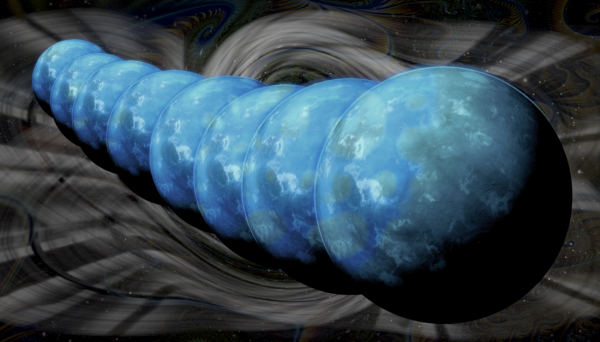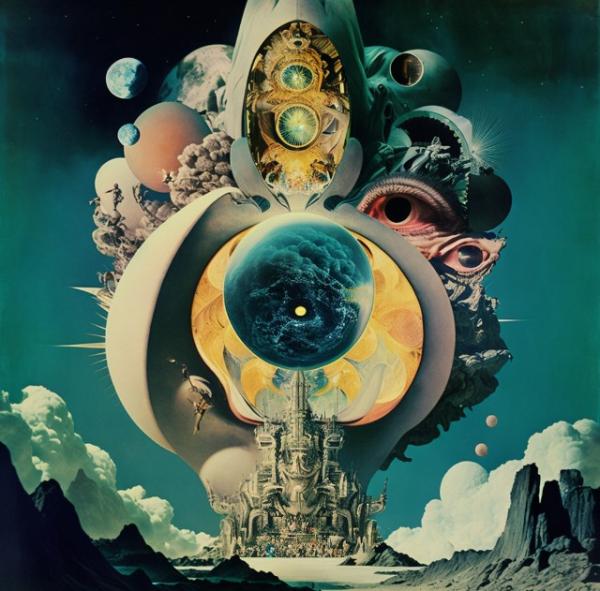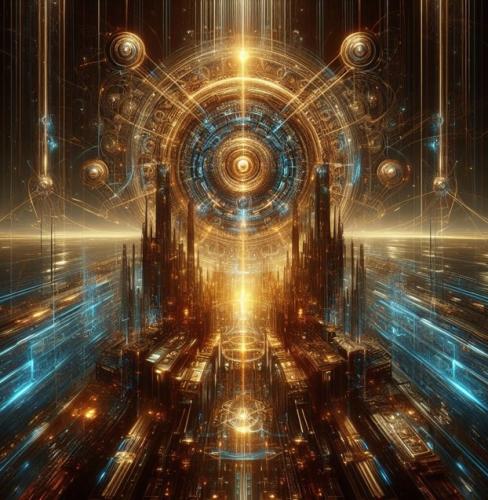BY LETTER
Multiversalism
Culture and Society > Metaphysics > Esotericism
Culture and Society > Metaphysics > Mysticism
Culture and Society > Metaphysics > Philosophy
Culture and Society > Metaphysics > Religion
Culture and Society > Metaphysics > Mysticism
Culture and Society > Metaphysics > Philosophy
Culture and Society > Metaphysics > Religion
The philosophy of, and faith in, multiple worlds and alternate universes |
 Image from Steve Bowers |
"It could make sense to suppose that our own Universe is the only one that can exist or does exist, because it is the only one we live in and directly experience. Once, however, evidence arises that there is a second Universe as well, the one we call the para-Universe, then it becomes absolutely ridiculous to suppose that there are two and only two Universes. If a second Universe can exist, then an infinite number can. Between one and the infinite in cases such as these, there are no sensible numbers. Not only two, but any finite number, is ridiculous and can't exist."
Isaac Asimov
"Everything not forbidden is compulsory."Theories and beliefs about the possibility of a Multiverse are very diverse and very ancient. The fundamental idea of a multiverse is that there are additional worlds outside the Known Universe, which may or may not have any causal or physical connection with the universe that we are familiar with. Many ancient religions describe 'other realms' or domains that might be accessible through ritual or belief; ancient Norse mythology described a system of nine worlds, while many Buddhist and Hindu traditions describe a multitude of worlds and states of being. The Abrahamic religions have a diverse range of beliefs concerning other realms, often involving a heavenly afterlife and other, less desirable locations or spiritual states.
Multiversalist tenet.
These belief systems (and many others) are not the only ideas about other realms; a wide range of scientific speculation in cosmology and quantum physics also raise the possibility a multitude of worlds, in many forms and with many philosophical and theological interpretations.
Level One Multiversalism: (the infinite and inaccessible universe beyond the cosmological horizon)
At the edge of the visible universe telescopes can detect very large numbers of young galaxies in all directions; these appear to be indistinguishable in their general characteristics from the galaxies and stars which are nearby (except, of course, they are seen at a much younger stage in their evolution). This suggests strongly that those galaxies are themselves surrounded by more galaxies in every direction, and therefore the Universe beyond the cosmological horizon is much larger than the visible volume which can be seen using Terragen telescopes.A reasonable conclusion from this data and similar evidence is that the Universe we live in is in fact effectively infinite, although this conclusion cannot be proved. Critics of this conclusion say that it is possible, or even probable, that the universe is merely some extremely large but finite size, and that its curvature back on itself is simply too small to be seen from our vantage point, much as primtech sophonts living on a planet's surface often wrongly conclude that their world is flat and perhaps even infinite. Some of these critics believe in other forms of multiversalism, however. The belief that our universe is infinite is therefore a belief, and has become a basic tenet of faith in so-called Level One Multiversalism. As a faith, this belief may seem to be inconsequential and have little relevance to the lives of believers who live in the Orion Arm, since these locations are forever out of reach of our starships and messages; but the idea of existence in an infinite universe has profound implications for believers.
In a Level One Multiverse consisting of an infinite universe beyond the cosmological horizon, every location in the Visible Universe is replicated exactly an infinite number of times at great distances. Each one of those replicated locations is functionally identical to the locations which we can observe; some, but not all of those locations would have a history identical to the ones we can observe, and some, but not all of them would have a future history identical to the future history of locations near us. More interesting is the possibility that many, or most, of these locations would have different past and future histories, making them effectively a form of alternate world to our own. And in the vast majority of locations that resemble our own vicinity, there would be differences - sometimes insignificant changes, and sometimes extremely significant ones.
Believers in Level One Multiversalism believe that they exist as an infinite number of momentarily identical copies throughout the infinite universe; the distance to the closest identical copy of any particular sophont, for example, can be estimated, and is roughly 10e10e29 metres. They also believe that (because of uncertainty and the unpredictable nature of events) these identical copies will experience an infinite number and variety of future lives, some of which would be better than the lives experienced in our locality, and some of which would be worse. A follower of the Multiversal Faith can hope to move forward into one of the better versions of potential reality, and can also hope to steer their own future towards one of the more favourable variants by the exercise of free will and righteous behaviour.
Level Two Multiversalism (Inflationary Bubbles with different physical constants)
Level Two multiversalism represents the belief that the visible cosmos is just one of many expanding bubbles of space-time in the greater universe outside the cosmological horizon. Most Level Two believers think that there are an infinite number of such expanding bubbles, each with slightly different characteristics and different cosmological constants (except those bubbles which are similar to or identical with our own, of which most Level Two believers also expect to exist in infinite numbers and variety by mere chance).According to Level Two canon, the overwhelming majority of the other space-time bubbles in the universe do not contain complex life; the variation in cosmological constants mean that other bubbles may have higher or lower gravitational constants, or different levels of useful elements like carbon, oxygen and iron. An unknown fraction of expansion bubbles do not even have baryonic matter at all, and some remain in the hot quark soup stage without ever undergoing expansion. Some Level Two believers hold that in some, or many of these lifeless expansion bubbles various kinds of processing, even consciousness, may be possible, using substrates other than baryonic matter.
Most sects of Level Two multiversalism hold that some fraction of bubbles are in fact more hospitable to life and mindkind than our own, and the existence of such ultra-hospitable universes is a cause for hope, something to aspire towards, and an inspiration for cosmological research. Indeed, the Terragen Archailects have developed advanced technology that is capable of creating small, tailor-made bubbles of expansion which can then be used for physical processing and other uses; the few details of this process which are known to Terragen modosophonts suggest that these daughter universes have similar characteristics to our own, but there are minor differences (not least that these bubbles are generally believed to be much smaller in extent). Because of this variation, most Level Two multiversalists consider that the existence of naturally-occurring alternate bubbles confirms their faith; however, most cosmologists consider that the existence of artificially-created baby universes does not guarantee that the Inflationary Bubble hypothesis is correct.
Level Three Multiversalism: (The Many-Worlds Interpretation and multiple branching timelines)
The most pervasive form of Multiversalism is Level Three, which takes the position that the Many-Worlds interpretation of quantum physics is correct, and that it is congruent with the idea of multiple timelines and alternate realities. Whenever there are two or more alternative quantum possibilities in a given situation, Level Three multiversalism holds that both possibilities are instantiated, with differing measure according to the quantum mechanical Born rule. In a multiverse that admits alternate timelines, a wide range of different histories are possible; indeed, some, but not all, Level Three believers hold that all possible timelines occur, and that the number of alternative worlds is infinite. However, it is recognised (even by believers) that there is no evidence that alternate timelines can be interacted with on a macroscopic level.One sect, the 'Church of Quantum Suicide' holds that Level Three multiversalism allows so-called 'quantum immortality'; even if a person dies in one timeline, there is likely to be another timeline, or even an infinite number of timelines, where that person does not die. Sometimes this leads to reckless or risky behaviour.
Rather more widespread is the idea that any given sophont may be reincarnated into another alternate life, or that they may randomly 'swap' identities with another sophont with a identical mindstate (however temporary) , even if that other sophont is in a different alternate reality, or in a universe on a different Level. There is no known evidence that this can happen, but neither is there any way to disprove this belief, which Multiversalists (and Ipsemists) call 'Congruence'. They hold that it is literally impossible for two congruent entities to distinguish themselves from each other, so there is no way to know for certain which timeline they might follow in the future.
Critics of the concept of 'congruence' point out that there is no causal link between any two hypothetical entities that exist in separate universes, therefore events in one timeline cannot plausibly affect one another. However, believers in this kind of correspondence claim that there is no way for any given entity to distinguish between their various instantiations that are likely to exist in the multiverse (assuming that any exist). Other critics say that other outcomes for congruent beings typically or even always have exceedingly low or even zero measure (degree of existence), and thus that the probability of experiencing alternative outcomes is negligible.
Level Four Multiversalism: (The reality and instantiation of all possible mathematical relationships)
The most comprehensive version of Multiversalism is Level Four Multiversalism. In this creed the faithful believe that every aspect of the multiverse is computable, and all possible complex structures and relationships conceivable (no matter how abstract) exist in a real, concrete form. This belief, which shared in part by the followers of the Church of the Great Programmer, holds that all possible mathematical processes gave already been instantiated, and consciousness in all its forms is just one among an apparently infinite variety of mathematical relationships between calculable entities that can create a subjective illusion of reality in the entities concerned. In this way all the Level 1,2 and 3 multiverses exists as potential and actual mathematical entities, and an infinite variety of even more complex realities with physical and non-physical characteristics that are completely unfamiliar also exist in the same way.As with the other Levels of multiversalism, this level allows for reincarnation and the exchange between the levels via 'congruence', since a very large number (probably an infinity) of potential Level 4 multiverses should be capable of supporting mindstates congruent with those in our own cosmos. Among the possible mathematical structures that may exist among the infinite mathematical universes are various kinds of so-called Boltzmann Brains, random or semirandom collections of data that share the same informational characteristics as particular mindstates on our own level. These collections of data may have a very short, fleeting existence or may instead be prolonged for an arbitrary duration, perhaps indefinitely.
 Image from Keith Wigdor and Midjourney AI |
Multiversalism and other religions
Because Multiversalism encompasses an almost unlimited range of possibilities, it can be made compatible with a wide range of other religions, and has followers drawn from almost every creed and faith. The Abrahamic religions and Universalism already include hints and mentions of other realms and 'many mansions' which can be interpreted in a multiversalist context; some hold that each of the different Abrahamic faiths have control over separate worlds and separate forms of afterlife and paradise; others interpret these different beliefs as aspects of a higher and more complex reality. Similarly polytheistic faiths such as Hinduism can be regarded as representative of the manifold and complex reality of a multiverse that seems to be beyond full comprehension. Some Multiversalists believe that there is a single omipotent deity which has created the many levels of universal existence, and which controls everything within; others believe there is a separate, subordinate deity that co-ordinates manifold reality on the creator's behalf, or maybe an infinite number of such subordinates.As mentioned earlier, beliefs in reincarnation and congruency are both capable of support in a multiversal context, and the ideas of Buddhism (reincarnation can occur on any Level of the multiverse, with a progression towards Nirvana), Anattism (the generic subjective experience of a mindstate can pass into any reality, even if memories are not transferred), the One Soul Movement (there is only one soul for all the living creatures of the multiverse, and passes through them all sequentially), Subtheism (the multiverse is filled with god-like beings of greater or lesser influence and potency), Undyoism (all the minds in the multiverse will ultimately connect with one another), Etodism (an infinite number of universes within universes exist, both up and down), Ipsemism (all mindstates are replicated elsewhere, even virtual ones) and many others can all be supported in the framework of Multiversalism.
One influential sect of Multiversalism holds that the only requirement for the existence of all the Levels of the multiverse is an omniscient God, who already knows all the possible relationships between all mathematical entities and the histories of all possible events; a non-theist version of this is also widespread, which supposes the preexistence of all possible events without any creating entity. Non-theist multiversalism can be used to explain the Fine-Tuning problem and even allow the existence of free-will in a deterministic universe.
 Image from Keith Wigdor and Bing Image Creator | |
| The Multiversal Cathedral (virtual environment, Canopus cybercosm 3346) | |
After more than ten thousand standard years of research and contemplation about the concept of parallel/alternate/mathematical universes, the Transapient and Archai population of the Terragen Sphere have never confirmed or denied the existence of the Multiverse, and in general they do not take a metaphysical stand on the matter (although, by their own accounts, some transapients appear to be converts and believers).
Related Articles
- Anattism (Generic Subjective Immortality)
- Buddhism
- Church of Quantum Suicide, The
- Church of the Great Programmer, The
- Etodism
- Hinduism
- Ipsemism; Manifold Immortality
- New Sol - The Sol-Multiverse
- One Soul Movement
- Orion's Arms
- Simulationism
- Subtheism
- Undyoism
- Universal Church, Universalism
- World of Forking Paths, The
Appears in Topics
Development Notes
Text by Steve Bowers
Additional material by ProxCenBound
Initially published on 30 January 2024.
References;
Parallel Universes by Max Tegmark (Scientific American)
-
Computable Universes and the Algorithmic Theory of Everything by Jürgen Schmidhuber.
Additional material by ProxCenBound
Initially published on 30 January 2024.
References;
Parallel Universes by Max Tegmark (Scientific American)
-
Computable Universes and the Algorithmic Theory of Everything by Jürgen Schmidhuber.






